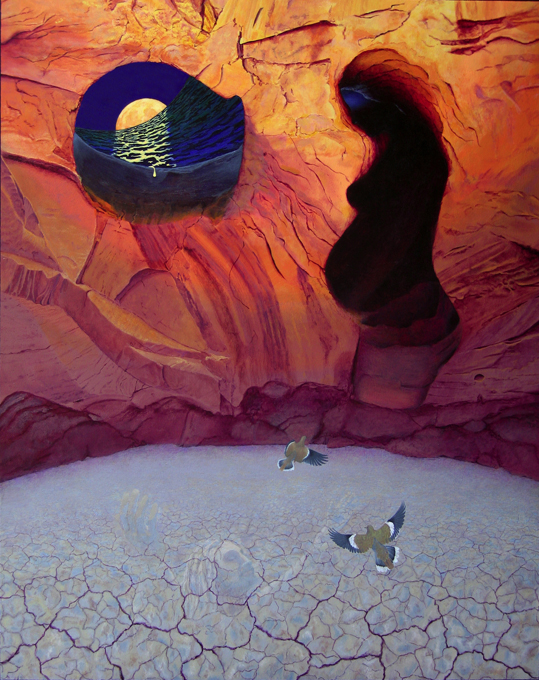

Another wall of the treasure-house is being built through the function of intuition, represented by the element water. We are looking at a type of rock formation that is in the U.S. southwest where holes are eroded in the rock face, sometimes they make a sort of cave like the structure on the right and other times they go all the way through like a doorway as in the structure on the left. The opening on the left contains the moon and the sea in an urn-like opening that I later learned is shaped like an Anasazi cooking vessel. The Anasazi are native to this area and the cooking vessel brings to mind the alchemical vessel. From the moon's sea a drop of water/light enters the picture plane. The cave on the right is in the form of the pregnant woman and we see a bit of light coming through in the area of the head, indicating that this structure also has an opening on the other side. Below, formed by the salts of the desert floor, is the shape of an Anthropos figure with arms raised upward (see detail). Flying up toward the cave is a pair of doves native to the area.
The first thing that comes to my mind about this image is that it is an intuitive glimpse of some aspect of the evolution of the god-image which seems to have begun in Western culture. I can only speculate that the unconscious feels it is necessary to have an image of the future of the psyche in the realm of one's intuitive function, the better to navigate our changing world, perhaps? One of the oldest ideas about the moon is that it is the source of all water on Earth and also anything that manifests on Earth is funneled through the portal of the moon. In my imagination, the moon's liquid, light/power of manifestation once flowed to the Anthropos/Christ figure below but as the aeon changes from Pisces to Aquarius (see Jung's Aion and Alice O. Howell's The Heavens Declare) the flow dries up for him and begins to flow toward the pregnant figure, the bearer of the new god-image. As this happens, the doves (Holy Spirit or spiritual essence) fly up to her. But these doves have undergone a transformation; they are no longer white but are also black. They carry the opposites toward the new god-image, which Jung says are essential for a complete image of god.
In Mysterium Coniunctionis I found much to amplify the painting: Water was thought to come from the moon in the form of dew. Wisdom/Sapientia/Sophia=salt. p. 129f: Concerning the symbolism of the moon, Jung writes that she is a kind of receptacle for the powers of the sun and the heavens and she collects this power in her moisture. She then funnels this energy into the Earth where she brings about the conception of this "sun seed" in the belly and womb of nature. The moon implants the virtues of the stars into sublunary things. Luna secretes a dew which is the water of life. There was thought to be a lunar sea. The alchemist Macrobius wrote: "But there is a certain property…and nature in the light that flows from it (the moon), which moistens bodies and bathes them as with a hidden dew." The moon gives bodies life and soul. Its waters purify the body in preparation for the soul. p.189f: Sea water or salt water is the alchemical aqua permanens, which is synonymous with the arcane substance, the spirit in matter, a medium where the opposites unite. The effect of the sea water in a psychological sense is the conscious realization and integration of an unconscious content. P.194: The alchemists thought of salt as a bird, a feminine principle that brings things into relationship with one another, i.e. as Sophia or Wisdom and also as Anthropos/Christ. The alchemical work was sometimes said to take place in the desert or wilderness.
In alchemical imagery, the falling dew occurs in the second stage of the opus and marks the return of the soul. The dew purifies the body (ego) and makes it ready for the soul or reconnection with the unconscious (see Edinger's The Mystery of the Coniunctio p.82f). In a psychological sense, the symbol of purity means we are conscious of our shadow, not that we have no negative aspects or have completely overcome them. It also means we realize there is something eternal in us but we are not that eternal thing, we simply give expression to it. This would be a conscious relationship to the unconscious.
The painting seems to be referring to both the individual and to society. On the one hand it describes the second stage of the opus for the individual and on the other, it seems to speak of the transformation of the god-image in the culture. I think the linking of these two ideas makes sense when looked at from the perspective of a reconnection with the unconscious because for the individual, the falling of the dew is a preparation for that connection and Jung tells us that a relationship to the unconscious (the light of nature) is what is missing from our god-image, which also points to a reconnection.
Presently, I am working on the painting for the element Earth, the final component for this quaternity of paintings.





